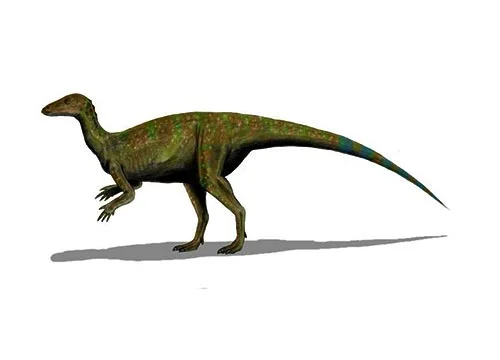Thescelosaurus (Wondrous lizard)

Fess-cul-o-sore-us
Charles W. Gilmore - 1913
Herbivore
Estimated 3 meters long
Euornithopod
T. neglectus, T. garbanii, T. assiniboiensis
Canada, Alberta - Dinosaur Park Formation, Oldman Formation, Scollard Formation, Saskatchewan - Frenchman Formation, Ravenscrag Formation. USA, Colorado - Laramie Formation, Montana - Hell Creek Formation, Lance Formation, New Mexico - Fruitland Formation, North Dakota - Hell Creek Formation, South Dakota - Hell Creek Formation, Lance Formation, Wyoming - Lance Formation
Late Cretaceous, 76-65 million years ago
Thescelosaurus Facts
Thescelosaurus, also known as the “wondrous lizard,” is a genus of ornithopod dinosaur that lived during the Late Cretaceous period, around 76-65 million years ago. Its fossils have been found in what is now modern-day North America.
Thescelosaurus was a small herbivorous dinosaur, measuring around 10 feet (3 meters) in length and weighing around 200-300 pounds (90-135 kilograms). It had a long, slender body, a small head with a toothless beak, and a long tail that was used for balance.
The name Thescelosaurus means “wondrous lizard” in reference to the unusual nature of its discovery. The first Thescelosaurus fossil was found by a group of amateur fossil hunters, and it was initially misidentified as a type of turtle. It wasn’t until later that it was recognized as a dinosaur, making its discovery all the more remarkable.
Thescelosaurus is an important dinosaur for paleontologists because it is one of the best-known small ornithopods from North America. Its fossils have been found in large numbers, and they have provided valuable insights into the anatomy, behavior, and ecology of this group of dinosaurs. In particular, Thescelosaurus is notable for its unique adaptations for chewing tough plant material, including a dental battery that allowed it to grind up its food efficiently.
Thescelosaurus likely lived in forested environments, where it would have browsed on low-growing vegetation. It may have been preyed upon by larger theropod dinosaurs, although its small size and agility may have allowed it to escape from predators.
The discovery of Thescelosaurus fossils has contributed to our understanding of the diversity and ecology of ornithopod dinosaurs during the Late Cretaceous period. Its unique adaptations for chewing tough plant material have also shed light on the evolutionary relationships between different groups of herbivorous dinosaurs.
In conclusion, Thescelosaurus is an important small ornithopod dinosaur from North America that lived during the Late Cretaceous period. Its unique adaptations for chewing tough plant material and its discovery by amateur fossil hunters make it a fascinating and significant dinosaur for paleontologists. The discovery of Thescelosaurus fossils has contributed to our understanding of the diversity and ecology of ornithopod dinosaurs during the Late Cretaceous period and has helped us better understand the evolutionary relationships between different groups of herbivorous dinosaurs.



